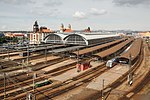State Opera (Prague)
1888 establishments in Austria-HungaryFellner & Helmer buildingsGerman diaspora in the Czech RepublicMusic venues completed in 1888Music venues in Prague ... and 3 more
Opera houses in the Czech RepublicTheatres completed in 1888Theatres in Prague

The State Opera (Czech: Státní opera), is an opera house in Prague, Czech Republic. It is part of the National Theatre of the Czech Republic, founded by Ministry of Culture of the Czech Republic in 1992. The theatre itself originally opened in 1888 as the New German Theatre and from 1949 to 1989 it was known as the Smetana Theatre. More recently it was renamed the Prague State Opera. Currently it is home to approximately 300 performances a year.
Excerpt from the Wikipedia article State Opera (Prague) (License: CC BY-SA 3.0, Authors, Images).State Opera (Prague)
Legerova, Prague Old Town
Geographical coordinates (GPS) Address Website External links Nearby Places Show on map
Geographical coordinates (GPS)
| Latitude | Longitude |
|---|---|
| N 50.080555555556 ° | E 14.432777777778 ° |
Address
Státní opera Praha
Legerova 57/75
110 00 Prague, Old Town
Prague, Czechia
Open on Google Maps









